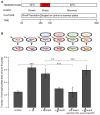Sex Pheromones of C. elegans Males Prime the Female Reproductive System and Ameliorate the Effects of Heat Stress
- PMID: 26645097
- PMCID: PMC4672928
- DOI: 10.1371/journal.pgen.1005729
Sex Pheromones of C. elegans Males Prime the Female Reproductive System and Ameliorate the Effects of Heat Stress
Abstract
Pheromones are secreted molecules that mediate animal communications. These olfactory signals can have substantial effects on physiology and likely play important roles in organismal survival in natural habitats. Here we show that a blend of two ascaroside pheromones produced by C. elegans males primes the female reproductive system in part by improving sperm guidance toward oocytes. Worms have different physiological responses to different ratios of the same two molecules, revealing an efficient mechanism for increasing coding potential of a limited repertoire of molecular signals. The endogenous function of the male sex pheromones has an important side benefit. It substantially ameliorates the detrimental effects of prolonged heat stress on hermaphrodite reproduction because it increases the effectiveness with which surviving gametes are used following stress. Hermaphroditic species are expected to lose female-specific traits in the course of evolution. Our results suggest that some of these traits could have serendipitous utility due to their ability to counter the effects of stress. We propose that this is a general mechanism by which some mating-related functions could be retained in hermaphroditic species, despite their expected decay.
Conflict of interest statement
The authors have declared that no competing interests exist.
Figures







References
-
- Jeong P-Y, Jung M, Yim YH, Kim H, Park M, Hong E, et al. Chemical structure and biological activity of the Caenorhabditis elegans dauer-inducing pheromone. Nature. 2005;433:541–545. - PubMed
-
- Butcher RA, Fujita M, Schroeder FC, Clardy J. Small-molecule pheromones that control dauer development in Caenorhabditis elegans . Nat Chem Biol. 2007;3:420–422. - PubMed
Publication types
MeSH terms
Substances
Grants and funding
LinkOut - more resources
Full Text Sources
Other Literature Sources

